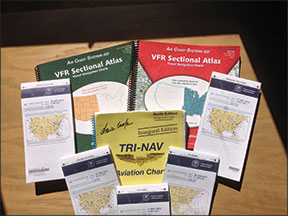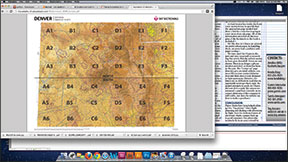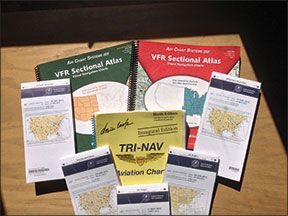Despite all the developments in the world of electronic charts, many pilots still like paper. Reasons include avoiding what can be pricey electronic device updates, a perceived ease in keeping track of the geographic “big picture” beyond the magenta line and not being quite convinced that electronics are infallible, are infallible, are infallible.
No matter what chart is used, the important factor is making sure that the most current information regarding a proposed flight is easily available—cost is a close second. For a paper-preferring pilot who routinely flies within an area covered by four to six Sectional Aeronautical Charts (sectionals), we think the best approach is to simply purchase a subscription for each.

If a pilot is routinely buying six or more sectionals, the equation changes to buying an annual subscription offered by one of the companies that print sectionals in spiral-bound volumes and provide an update service to allow the pilot to keep abreast of changes.
Part 91 pilots are not required to have current, or any, charts on board. However, they are required by Part 91.103 to become familiar with all available information concerning a flight prior to departure. A current chart or annual chart service that provides updates is, in our opinion, an easy way to comply.
Types
As it has been almost since Wilbur and Orville, the two main types of VFR charts are sectionals, with a 1:500,000 scale and World Aeronautical Charts (WAC), with a 1:1,000,000 scale. Both are supplemented, for areas covered by Class B airspace, with Terminal Area Charts (TAC), which have a scale of 1:250,000.
Because of the scale and lack of surface detail of WACs, their most common use seems to be in Part 135 operations where current charts are required, and VFR charts have to be on board when there is some portion of a flight that is not on an IFR clearance. For space and cost considerations, operators subscribe to the appropriate WAC charts.
The workaday chart is the sectional. For paper chart pilots, the question is the most economical method of maintaining a current collection that covers the right area.
Buying Sectionals
The current, standard price of a sectional chart is $9. If you are fortunate to have a pilot supply shop nearby, it’s easy to stop in and buy what you need. Barring that, a sectional may be purchased from the FAA (the AeroNav folks at the FAA produce the charts) through the faacharts.faa.gov website. For $34.20, you should be able to buy a subscription that ships you the most current chart as it is issued over the next two years, saving you $1.80 and that “Aw, nuts, my chart’s out of date” feeling. Unfortunately, our experience with trying to order a chart through the user-unfriendly website was so frustrating that we eventually gave up.
Mypilotstore.com sells sectionals for $7.50, a one-year subscription for $15.00 and has free shipping. Aircraft Spruce (www.aircraftspruce.com) also charges $7.50 for an individual sectional and offers free shipping. Spruce’s website said subscriptions were available, but every time we tried to set up a subscription, it only gave us one chart. Sporty’s (www.sportys.com) sticks with the $9.00 FAA price, offers subscriptions and charges $4.95 for shipping. Sporty’s also only gave us one chart when we tried to set up a subscription.
No Folding
While we believe that a part of pilot training should include unfolding and folding charts, there is hope for the folding impaired. Sky Sectionals sells downloadable sectionals for $9.99. Each sectional is broken into panels, which can be printed, full-size, on a standard sheet of paper. You keep a current sectional on your computer and print out the portions you wish, including potential diversions, for each trip.
Sky Sectionals also breaks the continental U.S. up into thirds and offers a subscription service for all of the sectionals in that third for $139 or the full lower 48 for $239 a year. If you want TACs as well, it’s a little more.

For the pilot who either lives near the corner or edge of a sectional or does a fair number of cross-countries a year, a subscription to the relevant sectionals can get pricey, and the number of folded maps can become unwieldy. A better solution may be a subscription to one of the companies that provides sectionals in a spiral-bound format.
Buy the Book
Tri-Nav Aviation Charts break up the continental U.S. into four regions, and present all of the sectionals in each region in a format that is only slightly larger than a standard sheet of paper. For $59 you get a book and updates every 28 days. You refer to the updates for the most current information—they tuck into a pocket in the back. The book includes all of the legends and associated information for the sectionals in the area such as MOAs, restricted airspace and ATC frequencies. Coverage of all of the lower 48 is $236. TACs are not included.
Air Chart Systems breaks the continental U.S. into east and west at the western border of Minnesota for its VFR Sectional Atlases. Its book is about 11×11 inches. Updates are provided every 28 days and are cumulative, so only the most recent needs to be kept. TACs are not included.
A chart locator key inside the front cover makes it easy to quickly find the appropriate page needed and draw a line for a trip that is going to cover more than one page.
We were surprised in researching this article that the website does not show prices, a phone number or any way to order charts. The “contact us” page does not even give an email address; you must fill out your contact information and then enter a code designed to fight spammers. However, the letters are so difficult to read that we apparently never got them right.
Repeated attempts to reach Air Charts did not elicit a reply. We cannot recommend a purchase currently as we cannot determine if the company is still viable.
Conclusion
Paper charts have long helped pilots get the “big picture” when flight planning and dealing with diversions in flight. Even for dedicated users of electronic charts, a paper backup is good insurance. For pilots who routinely fly in an area covered by six or fewer sectionals, we recommend getting a subscription for the sectionals, as we’ll as TACs, through Mypilotstore.com or Aircraft Spruce as they have the best prices and free shipping.
If you don’t want to wrestle with folding charts, the prices are reasonable and it’s easy to download and print off the sectional panels you need from SkySectionals.com.
Should you routinely travel more than a couple of hundred miles, the bound book of sectionals is, in our opinion, the convenient and economical way to go, so long as you are willing to check the updates. For that we like Tri-Nav’s size, arrangement and pricing.


